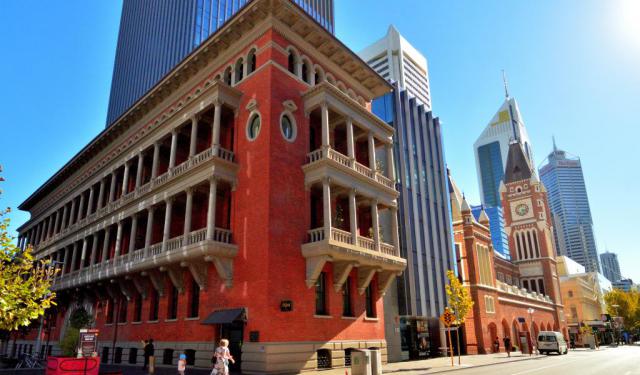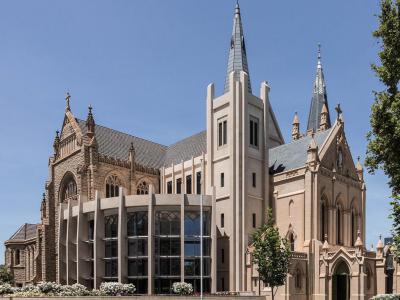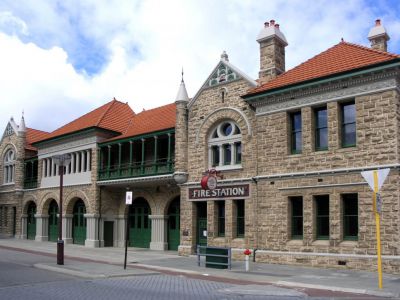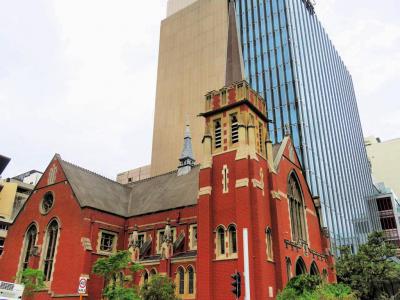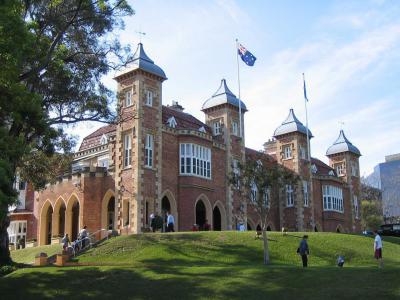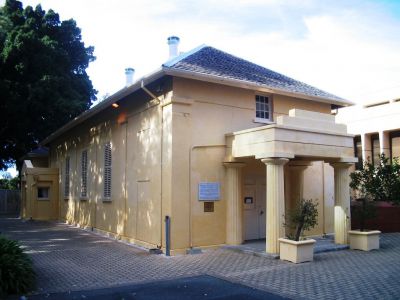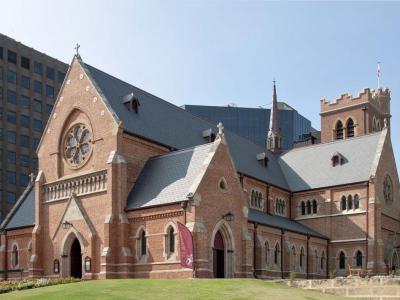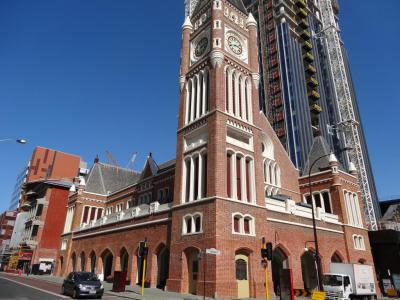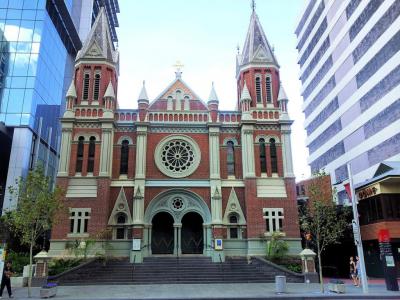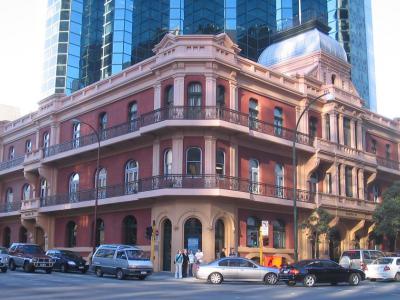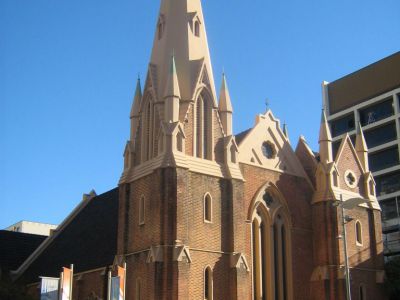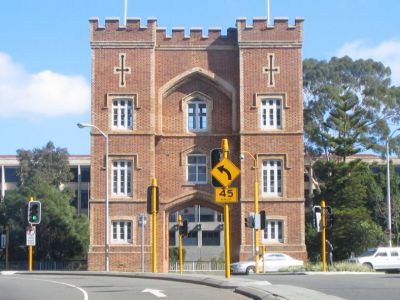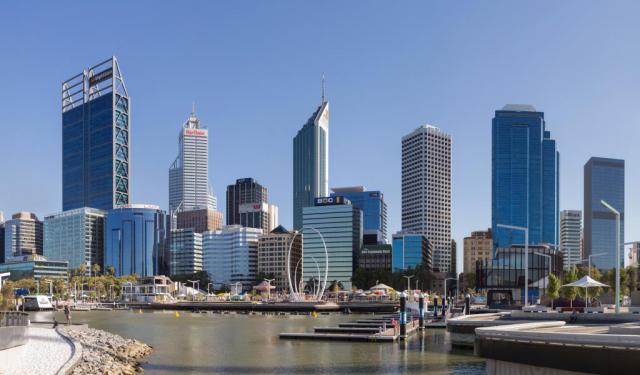Perth Historic Buildings Walk (Self Guided), Perth
Established by British settlers in 1829 and originally named the Swan River Colony, the city of Perth boasts a wealth of old buildings – governmental, religious, residential, commercial and institutional, – many of which are heritage-listed.
Just like other Western Australia’s settlements, the city struggled throughout the 1800s from the lack of resources, labor and investment. However, following the gold rushes of the 1890s Perth enjoyed a great influx of people and, subsequently, considerable development arising from the newly acquired wealth. Many ornate edifices in the metropolitan area, like the Palace Hotel on St Georges Terrace, date back to that period.
A mining boom in the 1960s-70s led to another wave of intensive development, but simultaneously caused the loss of much of Perth's early 1900s architecture. A greater awareness within the community of heritage places developed since then has resulted in a number of high-profile public campaigns that preserved several substantial buildings, such as the Pensioner Barracks (now the Barracks Arch), the Palace Hotel (currently offices for Bank of Western Australia) and others.
Among the old buildings in Perth still extant, recognized for their heritage significance, there are:
St. Mary's Cathedral – the seat of local Archbishop, begun in 1865;
St John's Pro-Cathedral – the earliest Roman Catholic church in Western Australia, constructed between 1843 and 1844;
Old Perth Fire Station – the first (1900) purpose-built fire station in WA;
Government House and Gardens – official residence of the Governor of Western Australia, built between 1859 and 1864;
Old Court House. Francis Burt Law Museum – the city's oldest surviving public building, dated from 1836-1837, nowadays home to the Francis Burt Law Education Centre and Museum;
Perth Town Hall and Perth Foundation Plaque – built using convict labor, from 1868 to 1870.
To explore these and other architectural monuments in Perth fit to excite both history buffs and lovers of design, take this self-guided walking tour.
Just like other Western Australia’s settlements, the city struggled throughout the 1800s from the lack of resources, labor and investment. However, following the gold rushes of the 1890s Perth enjoyed a great influx of people and, subsequently, considerable development arising from the newly acquired wealth. Many ornate edifices in the metropolitan area, like the Palace Hotel on St Georges Terrace, date back to that period.
A mining boom in the 1960s-70s led to another wave of intensive development, but simultaneously caused the loss of much of Perth's early 1900s architecture. A greater awareness within the community of heritage places developed since then has resulted in a number of high-profile public campaigns that preserved several substantial buildings, such as the Pensioner Barracks (now the Barracks Arch), the Palace Hotel (currently offices for Bank of Western Australia) and others.
Among the old buildings in Perth still extant, recognized for their heritage significance, there are:
St. Mary's Cathedral – the seat of local Archbishop, begun in 1865;
St John's Pro-Cathedral – the earliest Roman Catholic church in Western Australia, constructed between 1843 and 1844;
Old Perth Fire Station – the first (1900) purpose-built fire station in WA;
Government House and Gardens – official residence of the Governor of Western Australia, built between 1859 and 1864;
Old Court House. Francis Burt Law Museum – the city's oldest surviving public building, dated from 1836-1837, nowadays home to the Francis Burt Law Education Centre and Museum;
Perth Town Hall and Perth Foundation Plaque – built using convict labor, from 1868 to 1870.
To explore these and other architectural monuments in Perth fit to excite both history buffs and lovers of design, take this self-guided walking tour.
How it works: Download the app "GPSmyCity: Walks in 1K+ Cities" from Apple App Store or Google Play Store to your mobile phone or tablet. The app turns your mobile device into a personal tour guide and its built-in GPS navigation functions guide you from one tour stop to next. The app works offline, so no data plan is needed when traveling abroad.
Perth Historic Buildings Walk Map
Guide Name: Perth Historic Buildings Walk
Guide Location: Australia » Perth (See other walking tours in Perth)
Guide Type: Self-guided Walking Tour (Sightseeing)
# of Attractions: 12
Tour Duration: 2 Hour(s)
Travel Distance: 3.3 Km or 2.1 Miles
Author: irenebo
Sight(s) Featured in This Guide:
Guide Location: Australia » Perth (See other walking tours in Perth)
Guide Type: Self-guided Walking Tour (Sightseeing)
# of Attractions: 12
Tour Duration: 2 Hour(s)
Travel Distance: 3.3 Km or 2.1 Miles
Author: irenebo
Sight(s) Featured in This Guide:
- St. Mary's Cathedral
- St. John's Pro-Cathedral
- Old Perth Fire Station
- St. Andrew's Uniting Church
- Government House and Gardens
- Old Court House. Francis Burt Law Museum
- St. George's Cathedral
- Perth Town Hall and Perth Foundation Plaque
- Trinity Uniting Church
- Palace Hotel
- Wesley Uniting Church
- Barracks Arch
1) St. Mary's Cathedral (must see)
Saint Mary's Cathedral is a Roman Catholic cathedral in Victoria Square. It replaced the colony's first Roman Catholic church, Saint John's. The cathedral was designed by Joseph Ascione in the Norman Gothic architectural style.
The cathedral was constructed in three phases. The primary structure was completed in 1865. The second construction, completed in the 1920s, added a new transept and sanctuary. Mosaics in the sanctuary were patterned after designs from the Book of Kells. New stained glass windows were added, designed by John Hardman of the United Kingdom.
The final construction increased the size of the cathedral, added a second spire and included an underground parish center. During construction, the remains of the first bishops of Perth were found beneath the cathedral's floorboards. A permanent crypt for these bishops was then added to the architectural plans.
This construction was completed in 2009. The new design of the cathedral won three architectural design awards for its architect Peter M. Quinn.
The cathedral was constructed in three phases. The primary structure was completed in 1865. The second construction, completed in the 1920s, added a new transept and sanctuary. Mosaics in the sanctuary were patterned after designs from the Book of Kells. New stained glass windows were added, designed by John Hardman of the United Kingdom.
The final construction increased the size of the cathedral, added a second spire and included an underground parish center. During construction, the remains of the first bishops of Perth were found beneath the cathedral's floorboards. A permanent crypt for these bishops was then added to the architectural plans.
This construction was completed in 2009. The new design of the cathedral won three architectural design awards for its architect Peter M. Quinn.
2) St. John's Pro-Cathedral
The Saint John the Evangelist Pro-Cathedral holds a significant spot in Western Australia's Catholic heritage as the first Catholic church building in the area. Initially serving as both a church and the region's first cathedral, it was the heart of Catholic activities in the early days of the Swan River Colony. This role continued for the first two decades until the construction of the first Saint Mary's Cathedral in 1865.
The building's exterior is made of brick, coated with a lime mixture, and painted in an ochre hue to mimic its original color. Its roof, featuring a traditional gable design, is covered with shingles. The structure's long sides are marked by arched windows and strengthened by buttresses spaced evenly along its length. Although its portico was removed in 1881, it has since been rebuilt on the building's west side.
The west end of the cathedral showcases four arched windows, arranged with a pair above the portico and one on each side. On the south side, there's a small addition at the back, accessible through an arched doorway on the north side. The church's windows are simple, with clear glass framed by wooden sections, while the windows in the added part are square with four panes each.
The building's exterior is made of brick, coated with a lime mixture, and painted in an ochre hue to mimic its original color. Its roof, featuring a traditional gable design, is covered with shingles. The structure's long sides are marked by arched windows and strengthened by buttresses spaced evenly along its length. Although its portico was removed in 1881, it has since been rebuilt on the building's west side.
The west end of the cathedral showcases four arched windows, arranged with a pair above the portico and one on each side. On the south side, there's a small addition at the back, accessible through an arched doorway on the north side. The church's windows are simple, with clear glass framed by wooden sections, while the windows in the added part are square with four panes each.
3) Old Perth Fire Station
The Old Perth Fire Station, also known as Fire Brigade No. 1 Station, holds the distinction of being the first dedicated fire station in Western Australia, officially opening its doors in 1901 and serving until 1979.
Designed by architect Michael Cavanagh, the building showcases Romanesque Revival design elements and was constructed around the turn of the 20th century. It's a two-story structure made of rough limestone with a tiled roof, positioned on a corner lot. The building stands out with its varied front appearance, featuring archways, small towers, and recessed areas with columns.
After the Perth Fire Brigade moved out in 1979, the building underwent significant restoration from 1983 to 1985. The exterior restoration included replacing the roof with terracotta tiles to match the original, rebuilding a limestone archway to accommodate modern, larger fire engines (this had been previously modified with a concrete support), and restoring columns, decorative elements, and the original doors that had been removed. On the inside, renovations added new wooden staircases, bathrooms, and a small theater, along with new decorative ceiling edges and medallions to reflect the building's historical period.
In 1985, the building was repurposed and reopened as the Fire Safety Education Centre and Museum. This museum displays a wide range of firefighting gear used over the last 150 years, supported by a team of active firefighters. Located in the fire station first established in 1901, this facility was once among the most cutting-edge of its time in the country.
Designed by architect Michael Cavanagh, the building showcases Romanesque Revival design elements and was constructed around the turn of the 20th century. It's a two-story structure made of rough limestone with a tiled roof, positioned on a corner lot. The building stands out with its varied front appearance, featuring archways, small towers, and recessed areas with columns.
After the Perth Fire Brigade moved out in 1979, the building underwent significant restoration from 1983 to 1985. The exterior restoration included replacing the roof with terracotta tiles to match the original, rebuilding a limestone archway to accommodate modern, larger fire engines (this had been previously modified with a concrete support), and restoring columns, decorative elements, and the original doors that had been removed. On the inside, renovations added new wooden staircases, bathrooms, and a small theater, along with new decorative ceiling edges and medallions to reflect the building's historical period.
In 1985, the building was repurposed and reopened as the Fire Safety Education Centre and Museum. This museum displays a wide range of firefighting gear used over the last 150 years, supported by a team of active firefighters. Located in the fire station first established in 1901, this facility was once among the most cutting-edge of its time in the country.
4) St. Andrew's Uniting Church
Saint Andrew's Uniting Church was built in 1906. It was designed by James Hinse in a blend of Gothic and Arts and Crafts architectural styles. The building has standard nave and transepts as well as a bell tower with a metal spire.
Originally a Presbyterian Church, the building was purchased by a private entity, and then used as a Uniting Church. Services for Saint Andrew's Uniting Church moved to a new building in 2015 when the structure of the older building was no longer sound.
The church organ was built in 1924 by W.L. Roberts. It was rebuilt again in 1954 and 1986. The organ was removed after the church no longer held services.
The church is notable for being the first Presbyterian Church in Western Australia. It was added to the State Heritage List in 1985 and the State Register in 1996. It was given these honors for being a place of significant cultural importance in Western Australia.
Originally a Presbyterian Church, the building was purchased by a private entity, and then used as a Uniting Church. Services for Saint Andrew's Uniting Church moved to a new building in 2015 when the structure of the older building was no longer sound.
The church organ was built in 1924 by W.L. Roberts. It was rebuilt again in 1954 and 1986. The organ was removed after the church no longer held services.
The church is notable for being the first Presbyterian Church in Western Australia. It was added to the State Heritage List in 1985 and the State Register in 1996. It was given these honors for being a place of significant cultural importance in Western Australia.
5) Government House and Gardens
The Government House is the residence of the governor of Western Australia. Though the existing house was built in 1864, the site has been in use by governors of Western Australia since 1829 when the Swan River Colony was established. It is located on the primary thoroughfare in Perth near the Council House.
The house was built in the Jacobean Revival style from a design by Edmund Henderson. It was mostly built by convicts. Along with the house, a separate building called The Lodge was added in 1904 in the gardens. The Lodge is in the Federation Queen Anne architectural style.
The gardens at Government House consist of a meticulously crafted green space, shade trees, a walking path and outdoor art. The gardens are open to the public from 12 PM to 2 PM from Tuesday through Thursday.
The house and the gardens were listed on the Western Australian Register of Heritage Places in 2011.
The house was built in the Jacobean Revival style from a design by Edmund Henderson. It was mostly built by convicts. Along with the house, a separate building called The Lodge was added in 1904 in the gardens. The Lodge is in the Federation Queen Anne architectural style.
The gardens at Government House consist of a meticulously crafted green space, shade trees, a walking path and outdoor art. The gardens are open to the public from 12 PM to 2 PM from Tuesday through Thursday.
The house and the gardens were listed on the Western Australian Register of Heritage Places in 2011.
6) Old Court House. Francis Burt Law Museum
The Old Court House stands as Perth's inaugural courthouse, erected in Western Australia. Nestled amidst Stirling Gardens and Supreme Court Gardens, off Barrack Street, it stands adjacent to the Supreme Court edifice. This single-story cream-rendered structure boasts a wooden shingle roof.
Built in 1836, it holds the distinction of being the city's oldest extant public building and is among the last vestiges of Henry Reveley's architectural legacy, the colonial civil engineer. Notably, it exemplifies the classical Greek revival style prevalent in 19th-century Perth.
Its design reflects the simplicity of Georgian architecture, characterized by stone rubble construction with a stucco finish. The modest structure features a hipped roof originally covered in slate. A later addition, the entry portico, is upheld by Doric pillars. The surrounding area, particularly to the north and west, is adorned with sandstone-colored interlocking concrete paving bricks.
The Old Court House was formally recognized for its historical significance, entering the Register of the National Estate in October 1980 and receiving classification from the National Trust of Australia (WA) in February 1978. Subsequently, on 14 February 2003, it earned a permanent place on the state heritage register.
Contained within the Old Court House is the Francis Burt Law Museum, which showcases artifacts that illustrate the evolution of law in Western Australia. The collection spans from 1616 and comprises a diverse range of items, some of which are accessible for research. Among the artifacts are books, journals, photographs, legal attire, personal belongings, embossing presses, furniture, firearms, and evidence items. The primary courtroom is preserved in its 1800s state. Beyond its role as a museum, it serves as an educational and research hub.
Built in 1836, it holds the distinction of being the city's oldest extant public building and is among the last vestiges of Henry Reveley's architectural legacy, the colonial civil engineer. Notably, it exemplifies the classical Greek revival style prevalent in 19th-century Perth.
Its design reflects the simplicity of Georgian architecture, characterized by stone rubble construction with a stucco finish. The modest structure features a hipped roof originally covered in slate. A later addition, the entry portico, is upheld by Doric pillars. The surrounding area, particularly to the north and west, is adorned with sandstone-colored interlocking concrete paving bricks.
The Old Court House was formally recognized for its historical significance, entering the Register of the National Estate in October 1980 and receiving classification from the National Trust of Australia (WA) in February 1978. Subsequently, on 14 February 2003, it earned a permanent place on the state heritage register.
Contained within the Old Court House is the Francis Burt Law Museum, which showcases artifacts that illustrate the evolution of law in Western Australia. The collection spans from 1616 and comprises a diverse range of items, some of which are accessible for research. Among the artifacts are books, journals, photographs, legal attire, personal belongings, embossing presses, furniture, firearms, and evidence items. The primary courtroom is preserved in its 1800s state. Beyond its role as a museum, it serves as an educational and research hub.
7) St. George's Cathedral
Saint George's Cathedral, located in Perth, is a standout piece of architecture that is deeply important for both its history and its role as a church. Sitting on Saint Georges Terrace, it's not just a spot for religious services but a key part of Perth's background, showing off how the city has grown and changed since 1888. The cathedral, which came from the mind of Sydney architect Edmund Blacket, is a prime example of Gothic Revival design. It took over from an older building, making its mark on Perth's history even more.
The cathedral is built with materials that highlight Western Australia's natural bounty and craftsmanship, like local clay bricks and Victorian blue stone, all set on a base of Fremantle limestone. Its design nods to traditional Gothic styles but is distinctly local, thanks to its use of regional materials.
It's also located near where Perth's very first church, the "Rush Church," was built in 1829 by Frederick Irwin, right after the city was founded. This connection adds to the cathedral's historical depth, linking Perth's early Christian roots to today.
Saint George's Cathedral has shown its toughness and ability to adapt over time, particularly when an earthquake in 1968 damaged its bell tower. The restoration work from 2005 to 2008 not only fixed the damage but also added earthquake-proofing, blending the old with new safety measures.
The cathedral is also a community hub, known for pushing the envelope in religious teaching, engaging sermons, and a commitment to welcoming different faiths and celebrating music. Its innovative approach to theology and culture, including the unique Cathedral Education Centre, sets it apart in Australia.
The cathedral is built with materials that highlight Western Australia's natural bounty and craftsmanship, like local clay bricks and Victorian blue stone, all set on a base of Fremantle limestone. Its design nods to traditional Gothic styles but is distinctly local, thanks to its use of regional materials.
It's also located near where Perth's very first church, the "Rush Church," was built in 1829 by Frederick Irwin, right after the city was founded. This connection adds to the cathedral's historical depth, linking Perth's early Christian roots to today.
Saint George's Cathedral has shown its toughness and ability to adapt over time, particularly when an earthquake in 1968 damaged its bell tower. The restoration work from 2005 to 2008 not only fixed the damage but also added earthquake-proofing, blending the old with new safety measures.
The cathedral is also a community hub, known for pushing the envelope in religious teaching, engaging sermons, and a commitment to welcoming different faiths and celebrating music. Its innovative approach to theology and culture, including the unique Cathedral Education Centre, sets it apart in Australia.
8) Perth Town Hall and Perth Foundation Plaque
The Perth Town Hall stands out as the only town hall across Australia that was constructed with the help of convict labor. It was designed by Richard Roach Jewell and James Manning, showcasing the Victorian Free Gothic style, and its construction from 1867 to 1870 saw the involvement of both convicts and free individuals. Unique features of the hall include decorations inspired by convict life, such as window designs reminiscent of the broad arrow symbol and hangman's noose motifs.
The hall's cornerstone was set in place on May 24, 1867, by Governor Hampton during a lavish ceremony. Despite heavy rain, the event proceeded with a grand procession from the Government House and a staged battle by local military groups, demonstrating the community's resilience and spirit.
Perth's establishment goes back to 1829, credited to Captain James Stirling. The formal founding moment involved Mrs. Helen Dance cutting down a tree on August 12, 1829, a historical moment now marked by a plaque near the Town Hall.
Throughout the 20th century, the ground level of the Town Hall hosted a variety of businesses such as a pharmacy, bank, and various shops, offering the only public restrooms in the vicinity. These commercial entities and accompanying structures were cleared out before the early 2000s renovation.
For a long time, the Perth Town Hall was a key landmark in the city's civic landscape. Even today, it remains an impressive structure that continues to attract and fascinate visitors and locals alike.
The hall's cornerstone was set in place on May 24, 1867, by Governor Hampton during a lavish ceremony. Despite heavy rain, the event proceeded with a grand procession from the Government House and a staged battle by local military groups, demonstrating the community's resilience and spirit.
Perth's establishment goes back to 1829, credited to Captain James Stirling. The formal founding moment involved Mrs. Helen Dance cutting down a tree on August 12, 1829, a historical moment now marked by a plaque near the Town Hall.
Throughout the 20th century, the ground level of the Town Hall hosted a variety of businesses such as a pharmacy, bank, and various shops, offering the only public restrooms in the vicinity. These commercial entities and accompanying structures were cleared out before the early 2000s renovation.
For a long time, the Perth Town Hall was a key landmark in the city's civic landscape. Even today, it remains an impressive structure that continues to attract and fascinate visitors and locals alike.
9) Trinity Uniting Church
Trinity Church is a historical landmark in Perth, known as one of its oldest church buildings and a rare survivor of 19th-century colonial architecture in the city. The church's community began with Henry Trigg, who moved to the Swan River Colony in 1829. Initially, Trigg, a committed Congregationalist, participated in the first Anglican Church as a choirmaster. He later became involved with the Wesleyans but, by 1843, started hosting Congregational prayer meetings at his house.
By 1863, the growing congregation needed more space and chose to construct a chapel on Saint Georges Terrace, moving from their smaller William Street location. They bought the land, and Richard Roach Jewell was selected as the architect. The foundation stone was laid by Governor John Hampton on May 10, 1864, and builders Thomas Smith and William Buggins completed the church in 1865.
A significant expansion occurred on August 4, 1892, when it was decided to build a new church in front of the old one. This plan included constructing an adjoining office block to help finance the church's construction. This proposal was approved, leading to the dedication of the new Trinity Church in December 1893 and its opening in 1894. Additionally, a two-story office building, named Trinity House, was built next to the new church, facing Saint Georges Terrace.
Trinity Church (1893) stands out in the architectural scene of Perth due to its unique style, especially when compared to the predominantly Gothic-style churches in the city. Instead, Trinity adopts the Romanesque Revival style. Its main facade features two towers on either side, topped with octagonal spires covered in slate, along with a prominent rose window and a spacious entrance portal. Inside, the church is notable for its galleries adorned with cast iron railings and stained glass crafted by Ashwin of Sydney.
By 1863, the growing congregation needed more space and chose to construct a chapel on Saint Georges Terrace, moving from their smaller William Street location. They bought the land, and Richard Roach Jewell was selected as the architect. The foundation stone was laid by Governor John Hampton on May 10, 1864, and builders Thomas Smith and William Buggins completed the church in 1865.
A significant expansion occurred on August 4, 1892, when it was decided to build a new church in front of the old one. This plan included constructing an adjoining office block to help finance the church's construction. This proposal was approved, leading to the dedication of the new Trinity Church in December 1893 and its opening in 1894. Additionally, a two-story office building, named Trinity House, was built next to the new church, facing Saint Georges Terrace.
Trinity Church (1893) stands out in the architectural scene of Perth due to its unique style, especially when compared to the predominantly Gothic-style churches in the city. Instead, Trinity adopts the Romanesque Revival style. Its main facade features two towers on either side, topped with octagonal spires covered in slate, along with a prominent rose window and a spacious entrance portal. Inside, the church is notable for its galleries adorned with cast iron railings and stained glass crafted by Ashwin of Sydney.
10) Palace Hotel
The Palace Hotel is a notable three-level building recognized for its historical value, situated in the heart of the city's business area. Built in 1897 during Western Australia's gold rush, it initially served as a hotel before being repurposed into bank offices and workspaces in the 1980s. Today, it houses the Perth offices of several companies, including Woods Bagot, Adapptor, and Hatchd, at the intersection of Saint Georges Terrace and William Street, a key spot in the city's financial zone.
At its launch on March 18, 1897, the hotel, despite being a bit smaller than similar establishments in other major Australasian cities, was praised as one of the region's most impressive and stylish hotels.
The building showcases a "Federation Free Classical" architectural style, with three floors made of brick and iron. It was designed by Porter and Thomas, and constructed by John De Baun, a well-known figure in mining and real estate.
In June 1973, it was added to the National Trust of Australia's register, achieving permanent status in 1980 for being an exceptional representation of the era's architectural quality.
Efforts by The Palace Guards, the National Trust of Western Australia, and the general public in the lead-up to and during the 1980s renovations ensured the preservation of certain original aspects of the building.
Thanks to its elaborate design and central location, the hotel has been a key landmark in Perth throughout its existence, offering luxurious accommodations for business travelers and serving as a symbol of the state's prosperity during the gold rush.
Before the Perth Town Hall was built in 1870, the site, formerly occupied by the Freemasons' Hotel, was a major center for social and political gatherings in the town, hosting significant decisions like the creation of a local police force in 1851. When it was converted into bank offices in the 1980s, there was a strong sense of nostalgia and appreciation for its historical significance in local media.
At its launch on March 18, 1897, the hotel, despite being a bit smaller than similar establishments in other major Australasian cities, was praised as one of the region's most impressive and stylish hotels.
The building showcases a "Federation Free Classical" architectural style, with three floors made of brick and iron. It was designed by Porter and Thomas, and constructed by John De Baun, a well-known figure in mining and real estate.
In June 1973, it was added to the National Trust of Australia's register, achieving permanent status in 1980 for being an exceptional representation of the era's architectural quality.
Efforts by The Palace Guards, the National Trust of Western Australia, and the general public in the lead-up to and during the 1980s renovations ensured the preservation of certain original aspects of the building.
Thanks to its elaborate design and central location, the hotel has been a key landmark in Perth throughout its existence, offering luxurious accommodations for business travelers and serving as a symbol of the state's prosperity during the gold rush.
Before the Perth Town Hall was built in 1870, the site, formerly occupied by the Freemasons' Hotel, was a major center for social and political gatherings in the town, hosting significant decisions like the creation of a local police force in 1851. When it was converted into bank offices in the 1980s, there was a strong sense of nostalgia and appreciation for its historical significance in local media.
11) Wesley Uniting Church
Wesley Church is one of the city's oldest church buildings and a rare example of 19th-century Colonial architecture that's still standing. It's constructed from bricks that support the structure themselves, arranged in a specific pattern known as Flemish bond, and designed in a style from the Victorian era that's heavily influenced by gothic academic principles. This includes a prominent tower, sharply sloped roofs, walls with raised edges, decorative window frames, and reinforced walls.
The design of the church draws the eye upwards, thanks to its tall, narrow windows with detailed stonework on the east side. The walls are divided into sections by structural supports, enhancing the design around the large windows with plasterwork above them. The bricks used in the construction vary in color due to the inconsistent temperatures of the kilns they were fired in, creating a visually appealing checkered effect. At the top of the church is a 35-meter tall tower, topped with a decorative weathervane, and flanked by four smaller towers, each finished with metal tops. The smaller towers are echoed in the design of the northeast tower above the end wall. The roof is made from hand-cut timber and was originally covered with wooden shingles, though it was later replaced with clay tiles.
Richard Roach Jewell, an architect who also played several roles in the community, including church member and colonial clerk, designed Wesley Church. The church's foundation stone was placed on October 25, 1867, by Governor John Stephen Hampton, and it officially opened its doors on April 10, 1870.
The design of the church draws the eye upwards, thanks to its tall, narrow windows with detailed stonework on the east side. The walls are divided into sections by structural supports, enhancing the design around the large windows with plasterwork above them. The bricks used in the construction vary in color due to the inconsistent temperatures of the kilns they were fired in, creating a visually appealing checkered effect. At the top of the church is a 35-meter tall tower, topped with a decorative weathervane, and flanked by four smaller towers, each finished with metal tops. The smaller towers are echoed in the design of the northeast tower above the end wall. The roof is made from hand-cut timber and was originally covered with wooden shingles, though it was later replaced with clay tiles.
Richard Roach Jewell, an architect who also played several roles in the community, including church member and colonial clerk, designed Wesley Church. The church's foundation stone was placed on October 25, 1867, by Governor John Stephen Hampton, and it officially opened its doors on April 10, 1870.
12) Barracks Arch
The Barracks Arch in Perth is a historical edifice with a rich past, emblematic of the region's colonial history and architectural evolution. Designed by the distinguished architect Richard Roach Jewell, the Barracks were constructed between 1863 and 1866 to accommodate the Enrolled Pensioner Force, a unique element of Western Australia's colonial defence.
Jewell's design for the three-storey building is a testament to the Tudor architectural style, echoing the grandeur and defensive prowess of a medieval castle. Despite the financial constraints that led to the choice of brick over stone, Jewell managed to accentuate the building's aesthetic appeal through the strategic use of paler color bricks beneath the windows and timber shingles for the roof. The Barracks, finished in 1866, were later expanded to accommodate 21 more families. Each family was provided with a two-room apartment featuring a fireplace, emphasizing the functional design.
The complex was not just residential but included various outbuildings like a cookhouse, firing range and gun-room, wash-house, stores and stables, and a fives court added later, indicating a self-sufficient community within its walls.
In 1887, a fire severely damaged parts of the building, necessitating restoration. By the turn of the 20th century, the Barracks transitioned from military use to become the headquarters of the Public Works Department between 1900 and 1904, highlighting its adaptive reuse over time.
However, the 1960s marked a turning point when plans for the Mitchell Freeway and the desire to clear views from Parliament House led to the government's intention to demolish the Barracks. This decision was partially executed by demolishing the third and fourth bays of windows. Yet, the Arch itself was spared, a decision driven by public demand for its preservation. The survival of the Barracks Arch, amidst the controversy, stands as a symbol of community attachment to heritage and history.
Jewell's design for the three-storey building is a testament to the Tudor architectural style, echoing the grandeur and defensive prowess of a medieval castle. Despite the financial constraints that led to the choice of brick over stone, Jewell managed to accentuate the building's aesthetic appeal through the strategic use of paler color bricks beneath the windows and timber shingles for the roof. The Barracks, finished in 1866, were later expanded to accommodate 21 more families. Each family was provided with a two-room apartment featuring a fireplace, emphasizing the functional design.
The complex was not just residential but included various outbuildings like a cookhouse, firing range and gun-room, wash-house, stores and stables, and a fives court added later, indicating a self-sufficient community within its walls.
In 1887, a fire severely damaged parts of the building, necessitating restoration. By the turn of the 20th century, the Barracks transitioned from military use to become the headquarters of the Public Works Department between 1900 and 1904, highlighting its adaptive reuse over time.
However, the 1960s marked a turning point when plans for the Mitchell Freeway and the desire to clear views from Parliament House led to the government's intention to demolish the Barracks. This decision was partially executed by demolishing the third and fourth bays of windows. Yet, the Arch itself was spared, a decision driven by public demand for its preservation. The survival of the Barracks Arch, amidst the controversy, stands as a symbol of community attachment to heritage and history.
Walking Tours in Perth, Australia
Create Your Own Walk in Perth
Creating your own self-guided walk in Perth is easy and fun. Choose the city attractions that you want to see and a walk route map will be created just for you. You can even set your hotel as the start point of the walk.
Perth Introduction Walking Tour
Perth is the capital of Western Australia. With a population of more than 2 million, the metropolitan area is the fourth largest in the country.
Perth was founded by Captain James Stirling in 1829. It was the first free-settler colony in Australia established by private capital. The official foundation ceremony took place on 12 August 1829 with the chopping down of a tree. Today a plaque set... view more
Tour Duration: 2 Hour(s)
Travel Distance: 4.2 Km or 2.6 Miles
Perth was founded by Captain James Stirling in 1829. It was the first free-settler colony in Australia established by private capital. The official foundation ceremony took place on 12 August 1829 with the chopping down of a tree. Today a plaque set... view more
Tour Duration: 2 Hour(s)
Travel Distance: 4.2 Km or 2.6 Miles
The Most Popular Cities
/ view all
